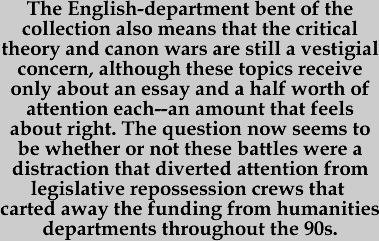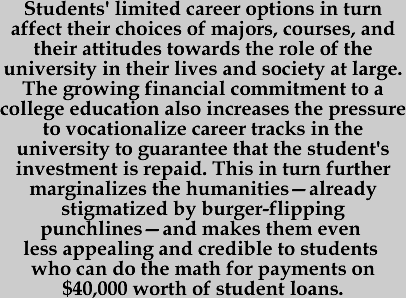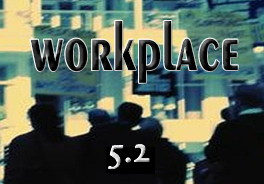![]()
Beyond the Corporate
University: Culture
and Pedagogy in the New Millennium
edited by Henry
Giroux and Kostas Myrsiades
Rowman & Littlefield, 2001
Floyd Olive
1.
A sequel of sorts to “university in crisis” collections like Cary Nelson
and Michael Bérubé’s Higher Education Under Fire (1995), the 16
essays in this book take a renewed look at the intensifying incursions
of corporate money, influence, and ideology into the university. Divided into four sections, the essays range from theoretical overviews
to specific suggestions for radical pedagogies that resist the pressure
to adopt a vocational training model of higher education. The common theme
of the essays is the problem of creating engaged public citizens in a
university increasingly influenced by private corporate ideologies, amidst
a society in which the public mission of universities has been largely
forgotten by citizens and their elected representatives.
Divided into four sections, the essays range from theoretical overviews
to specific suggestions for radical pedagogies that resist the pressure
to adopt a vocational training model of higher education. The common theme
of the essays is the problem of creating engaged public citizens in a
university increasingly influenced by private corporate ideologies, amidst
a society in which the public mission of universities has been largely
forgotten by citizens and their elected representatives.
2.
The essays center around English departments and their Rhetoric/Composition
and Cultural Studies siblings, so the book is primarily focused on the
effect of corporatization in the humanities. It would be wonderful to
see an essay or two from the point of view of a biologist or chemist examining
the effects of corporate culture in the sciences, where the grants and
corporate partnerships have numbers with far more zeroes, and the pressure
and temptation to play along is certainly far greater than it is in the
Philosophy department. But the humanities focus is apt, as these departments
are often the only ones to offer students the tools to question and critique
the corporate ethos, and are also the most besieged by legislators seeking
to cut the “fat” from university budgets.
3.
The English-department bent of the collection also means that the critical
theory and canon wars are still a vestigial concern, although these topics
receive only about an essay and a half worth of attention each—an amount
that feels about right. The question now seems to be whether or not these
battles were a distraction that diverted attention from legislative repossession
crews that carted away the funding from humanities departments throughout
the 90s. One of the most incisive comments about this misdirection game
appears in a footnote, where Jeffrey Williams quotes an acerbic Michael
Bérubé saying “The discipline thinks it’s moving from literature to culture
[i.e. cultural studies], while the [job] market tells us we’re moving
from literature to technical writing” (27).
4.
The first of the four sections, “Higher Education and the Politic of Corporate
Culture,” takes the highest-level view of these problems and also proves
to be the most thought-provoking and rewarding. Williams’ essay “Franchising
the University” leads off the collection and summarizes its concerns.
Two issues—the attenuation of the university’s mission to create public
citizens rather than corporate specialists, and the corollary dilemma
of the corporatization of the university structure itself—are problems
that have haunted professors in the humanities for decades, but never
more immediately than they do now. As Williams writes, “Universities are
now being conscripted directly as training grounds for the corporate workforce.
. . . In fact, university work has been more directly construed to serve
not only corporate-profit agendas via its grant-supplicant status, but
universities have become franchises in their own right, reconfigured to
corporate management, labor, and consumer models and delivering a name-brand
product” (18).
5.
Williams puts a useful face on the dilemma when he compares the 1963 Jerry
Lewis film The Nutty Professor to the 1996 Eddie Murphy remake.
In the original, the distracted Professor Kelp is chastised by the dean
for neglect of his teaching, while in the remake Murphy’s Professor Klump
is reprimanded for the very different reason of neglecting his potentially
lucrative research duties. Williams reads into this subtle difference
a change in public assumptions about the role of the university and the
professor’s mission—it didn’t need to be pointed out to the filmgoing
public in 1963 that Kelp’s first duty was teaching, just as it goes without
saying in the remake that the professor’s primary job is in the lab. Further,
in the remake the assumption is that these experiments are valuable because
they can make  money
for the university, which is seen less as an institution for educating
the young than as a business seeking a big sale. Williams contends that
in the American mind the missions of the corporation and the university
have elided—both are profit-motivated organizations that are ultimately
concerned with the bottom line. It follows then that appeals to public
sentiment to support the common good through education funding are less
likely to find sympathetic ears than the competing conservative messages
of efficiency and self-reliance.
money
for the university, which is seen less as an institution for educating
the young than as a business seeking a big sale. Williams contends that
in the American mind the missions of the corporation and the university
have elided—both are profit-motivated organizations that are ultimately
concerned with the bottom line. It follows then that appeals to public
sentiment to support the common good through education funding are less
likely to find sympathetic ears than the competing conservative messages
of efficiency and self-reliance.
6.
In Hollywood U’s real-world counterpart, the change has been less amusing
but just as pronounced. Another essay traces the enormous rise in corporate
contributions to the university—from $850 million in 1985 to $4.25 billion
just a decade later—a trend that highlights the indebtedness of the modern
university to private business (Kumar, 218). Williams discusses the effect
of the shift in mission from universities as public institutions to private
partnerships, and the various carrots and sticks used to encourage professors
to seek out these partnerships and the grant money that accompanies them.
In a telling instance, one of Williams’ teaching institutions offered
publication credit to faculty members for grant proposals submitted: four
grant proposals equaled one article. Williams recounts his dismay as the
dean “by fiat seemed to rewrite our professional self-definition, from
scholarship to salesmanship” (16). These kinds of profit-driven, top-down
managerial decisions by university administrations—increasingly hierarchical
and corporate in structure and independent of professorial control—are
just as great a threat to the mission of the university as the dependence
on private funding.
7.
Williams also addresses the often-overlooked demand side of the corporate
university equation: the increasing leverage that loans have over students’
educational opportunities and choices. Our students are incurring levels
of debt undreamt of by previous generations. Student loan payments can
linger for a decade after school is completed, and, unlike credit card
or mortgage debt, must be repaid even in the event of bankruptcy. The
effect of this debt is to close off many avenues of opportunity that don’t
involve a corporate paycheck, like public service, the arts, and other
culturally central but low-paying occupations. Students’ limited career
options in turn affect their choices of majors, courses, and their attitudes
towards the role of the university in their lives and society at large.
The growing financial commitment to a college education also increases
the pressure to vocationalize career tracks in the university to guarantee
that the student’s investment is repaid. This in turn further marginalizes
the humanities—already stigmatized by burger-flipping punchlines—and makes
them even less appealing and credible to students who can do the math
for payments on $40,000 worth of student loans.
8.
The lines of argument in this and the other introductory essays will be
familiar to those who have followed the literature of the last decade
or two that examines corporate influence on academia. Indeed, many of
the essays reference the work of Gerald Graff, Paul Lauter, Staney Aronowitz,
Cary Nelson, and Michael Bérubé, and build on their conclusions. Some
of the authors examine longer patterns of influence, invoking Kant and
Matthew Arnold to establish the changing historical conceptions of the
university and its roles of both reproducing society and promoting the
public good—roles that even Arnold admitted were not always in alignment.
Phillips’ essay, “Culture, the Academy and the Police,” explores this
history at length as he examines the duality of Arnold’s concern with
education as a means of promoting the “project of freedom” that would
elevate citizens through education, and his somewhat contradictory interest
in the “project of social control” that would keep a lid on any revolutionary
impulses that might arise in an educated populace (110).
9.
In sections three and four of the collection, “The Responsibility of Literature
and the Possibility of Politics” and “Making the Pedagogical More Political,”
the dominant critical framework is Marxist, whether it is the postmodern
Marxism of Christopher Wise’s “The Case for Jameson,” the more straightforward
critique of the hegemonic university in Barbara Foley’s “Subversion and
Oppositionality in the Academy,” or the feminist Marxism of Lynn Worsham’s
“Going Postal.” While there are many points of interest in these essays,
it would be helpful to have some more diversity of approach in the chorus
of voices decrying the corporatization of the university. While the tools
of Marxist analysis are useful to describe the processes by which capital
can hold the university in thrall, the non-Marxist left certainly has
something to say about how to challenge or modify the reproduction of
power structures through the educational system. Perhaps more to the point,
it seems unlikely that smash-the-corporate-state rhetoric will improve
any state university’s chances of maintaining funding levels during a
recession.
10. While
some might criticize more moderate approaches as self-censoring genuflections
to the university’s new corporate overlords, the “radical” viewpoint can
just as easily lapse into an embrace of marginality safely contained in
a few isolated classrooms rather than expressed through the fiscal and
public policy of the university. These latter functions, Rod Strickland
points out in “Curriculum Mortis,” are increasingly beyond the grasp of
professors in the hierarchical corporate structure of the modern university.
“Political and intellectual conflicts among faculty and students are displaced
to the level of administration,” where “power struggles are hidden behind
closed doors as administrators negotiate funding levels” (75). Strickland’s
essay reminds us that we need to fight the corporate university on at
least two levels. In the long term, we can help produce thoughtful citizens—who
can then shape public policy—as we make visible for our students the imperatives
of capital. But we must also act in the short term, by regaining the power
relinquished by the professoriate.
11.
Finally, while Roger Simon examines the Canadian university system in
“The University: A Place to Think?,” the rest of the collection is focused
on the United States and noticeably lacks comparisons with the current
status of the academy in other countries. Has Britain’s tiered education
system or France’s test-dominated approach proven more or less effective
in resisting corporate influence? Does democratic access (however imperfect
that access may be) to university education in the United States come
with costs that are unique to our social and educational systems?
12. Although the trend toward a corporatized academy continues, the takeover is far from complete and the critical tools for examining and discussing the problem have grown considerably more sophisticated. Beyond the Corporate University is a valuable addition to the literature and contains many thought-provoking discussions of issues that should concern any professor in the humanities.
